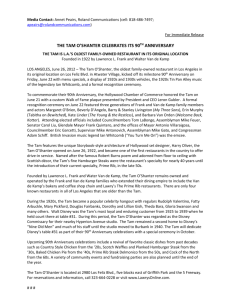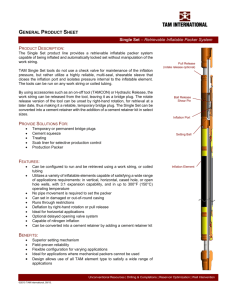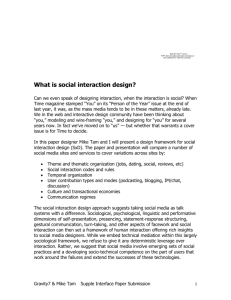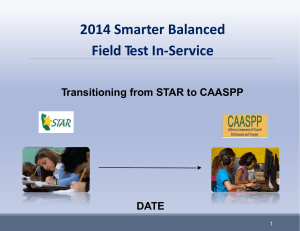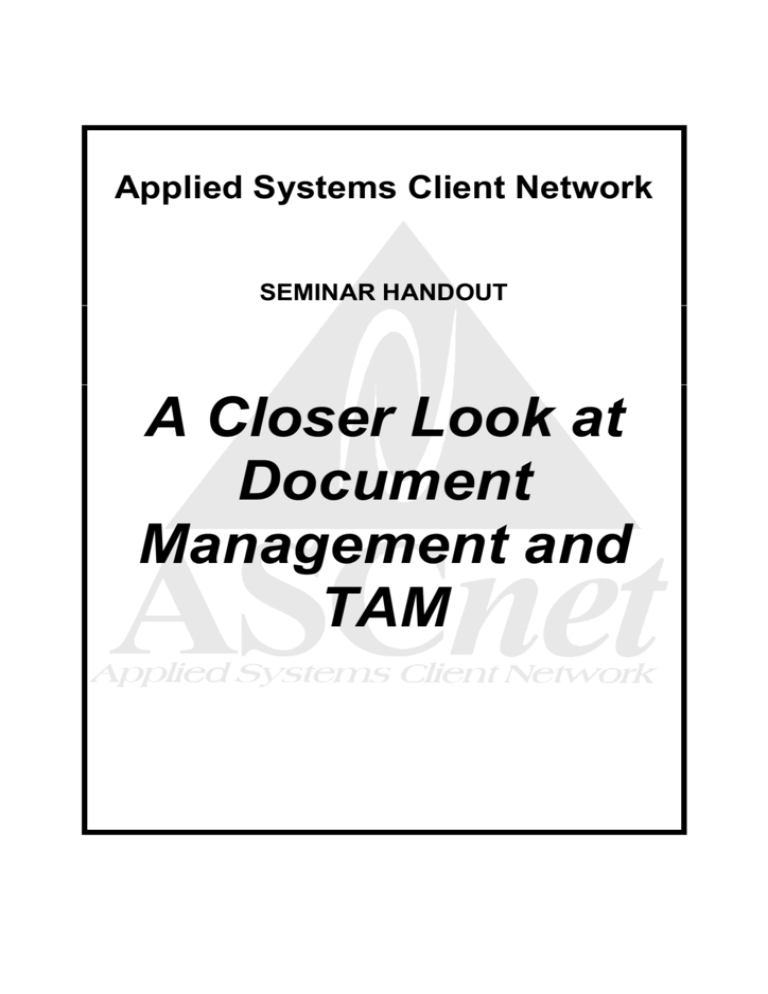
Applied Systems Client Network
SEMINAR HANDOUT
A Closer Look at
Document
Management and
TAM
A Closer Look at Document Management and TAM
Prepared for ASCnet
Applied Systems Client Network
801 Douglas Avenue #205
Altamonte Springs, FL 32714
Phone: 407-869-0404 Fax: 407-869-0418
Copyright 2008 by Applied Systems Client Network, Inc. (ASCnet), 801 Douglas Avenue #205, Altamonte Springs, FL 32614.
Protection claimed in all forms and matters of copyrightable material and information now allowed by law or hereafter granted
including both electronic and conventional distribution of herein products. Reproduction or transmission unless authorized by
ASCnet is prohibited. All rights reserved. Specific product information regarding Applied Systems’ The Agency Manager and
Vision, as well as other products copyrighted and mentioned within (ex: Microsoft, Excel, etc.) are the product of the individual
company and no endorsement or ownership of product should be implied by its mention and use. All workflows are suggested and
common workflows. Users of this material agree that ASCnet cannot be held liable for any omissions or errors within the guide.
Original Author:
Sandy Oliver, AIS Technology
Tracy Ustinov, Applied Systems
Contributing Authors:
Steve Booth, DHNT Insurance
Presented by:
Name
Where From
Contact Info
September, 2007
2
A Closer Look at Document Management and TAM
Objective: To define scanning terminology, provide direction for designing a scanning
workflow in an agency, and demonstrate the technology available in TAM for a scanning
agency.
Assumptions: This seminar is based on the following:
TAM Version 9.0
Table of Contents
Terms Defined................................................................................................................. 4
Considerations for developing your agency’s paperless process.................................... 5
When are you going to scan? ...................................................................................... 5
Who is going to scan? ................................................................................................. 5
Where are you going to scan? ..................................................................................... 5
What are you going to scan? ....................................................................................... 5
What are you going to scan into? ................................................................................ 5
Document Management Workflows introduced in TAM 8.0............................................. 6
Where do I begin? ....................................................................................................... 6
Attachment Definitions................................................................................................. 6
Attachment Security..................................................................................................... 6
How well is TAM suited for efiling?.................................................................................. 9
TAM Workflows for Email .............................................................................................. 10
Attaching from Homebase ......................................................................................... 10
Attaching from the Entity............................................................................................ 10
Sending and Attaching in a single operation.............................................................. 11
TAM Workflows for Images and Files............................................................................ 12
Attaching from Utility Manager................................................................................... 12
Attaching from Homebase/Efiling............................................................................... 12
Printing a Barcode ..................................................................................................... 13
Image Scan/Batch Attach .......................................................................................... 15
Scanning Guidelines ..................................................................................................... 15
Hardware Requirements............................................................................................ 15
Applied On-Line Changes.......................................................................................... 15
Bar coding Recommendations................................................................................... 16
References.................................................................................................................... 16
TAM Helpfile .............................................................................................................. 16
Webinars ................................................................................................................... 16
ASCnet Newsgroups ................................................................................................. 16
September, 2007
3
A Closer Look at Document Management and TAM
Terms Defined
Front End Scanning
Scanning of the paper is performed BEFORE it is distributed for work to be performed.
Back End Scanning
Scanning of the paper is performed AFTER the work has been performed.
Desktop Scanning
The majority of the scanning is performed via scan devices on each desktop.
Bar Coding
The process of generating a bar code from TAM similar to a UPC code on most
products purchased at a store. This bar code allows a mass scanning process to occur.
Each bar code is unique to the document to which it is generated for. This bar code is
read by TAM and automatically attaches the document to the correct client with the
correct category codes.
Duplex Scanning
The ability to scan the front and back of a piece of paper in a single pass.
DPI
Dots Per Inch. The measure of the print’s quality. Standard is between 300 and 600.
The bigger the number the better the quality of the image.
PPM
Pages Per Minute. The number of pages your scanner can process per minute.
Workflow audit – don’t forget that efiling creates a need to assure that the staff
is follow procedures – similar to t-filing. Documents that are scanned must be
stored for a short term until an audit can be performed and validate that all
documents were processed per written procedure.
Attachment Category
This field in TAM allows an agency to identify the type of document that is attached.
There is a sub-category field as well. The attachment field is totally controlled through
Security.
September, 2007
4
A Closer Look at Document Management and TAM
Considerations for developing your agency’s paperless process
When are you going to scan?
Are you going to scan paper when it comes into the agency, or as it passes through the
staff or in a batch process at a scheduled time each day?
Who is going to scan?
Will there be a dedicated person who scans all agency work? Perhaps departmental
scanning is a better fit. Will each person scan their own work?
Where are you going to scan?
Are you going to scan on individual desks, in departments or in an agency wide
standard location?
What are you going to scan?
Which pieces of paper need to be scanned and saved? THIS IS A VERY DIFFICULT
QUESTION and the most important consideration to make!!! Not every piece of
paper needs to be saved in the agency if you think through it. Be sure to keep State
retention requirements in mind as well as E&O concerns. It may take you six to nine
months to create the necessary workflows for all paper – or images - that enter your
agency. With more and more carriers going paperless, there is far less paper to scan,
but now decisions must be made on who stores your dec pages – you or the insurance
carrier?
What are you going to scan into?
Are you going to scan into TAM or perhaps a third party solution? We are going to look
at TAM’s ability to store and retrieve many types of electronic files and your controls
over these attachments.
September, 2007
5
A Closer Look at Document Management and TAM
Document Management Workflows introduced in TAM 8.0
The concept of document management truly began with the release of TAM 7.1
Previous versions of TAM handled your emails, formletters, proposals, spreadsheets
and images as separate pieces. Document Management was difficult to achieve if you
had to access different lists to get the entire picture. The consolidation of all these
items became what we know today as Attachments. We will discuss the various
workflows available in TAM, as well as discuss how the Batch Scanning feature can
augment your current process.
Where do I begin?
The most difficult part of planning for your agency is done once you’ve answered all the
questions earlier in this document. Now it’s time to put your plan into action! A few
more important decisions need to be before configuring TAM.
Attachment Definitions
The next step would be to determine Attachment Categories. How you define those
categories is very critical since TAM uses these categories for security access. TAM
does provide a predefined list, but this list can be modified by your agency to fit your
needs. Where do you define Attachment Categories, Attachment Subcategories
and Attachment Descriptions?
From Utility Manager,
select Field Defaults,
Define Attachment
Categories,
Attachment
Subcategories or
Attachment
Descriptions
Attachment Security
Who will have rights to attachments?
What rights (Add, View, Revise or Delete) will those individuals have?
Will those rights be unique to the entity type?
Will rights be based on file types?
What is the easiest way to control those rights through Security?
September, 2007
6
A Closer Look at Document Management and TAM
There have been many agencies who have rushed into creation and management of
Categories and now have an untamed beast at their desktop. If you will take the time to
think through the fact that Categories are tied directly to Security, then you may get a
better grasp on this area. There are many users in the ASCnet Newsgroups who are
more than willing to discuss or share their office strategies in Categories.
You may want to consider a Category as
what the item is – email, document, dec
page, photo, proposal, draft, application, ect
– and utilize the Sub-Categories for extra
sorting.
With the categories in place, you now need to define security access. For each entity
type in TAM – customer, prospect, company - you will define the rights for each
category. This will allow you to define who has access per function and category for
each entity.
It is considered a better procedure to create
Security Groups to control access to
attachments. A group can be setup to
provide only one level of Category access. It
makes it easier for E&O purposes to look at
members of a group to see who has rights to
certain Categories based on what is
provided by the groups they belong to.
September, 2007
7
A Closer Look at Document Management and TAM
As you can see, the Security
Group ‘HIPPA” contains only
references to accessibility to
the Benefits attachments.
We can see that the user
“CATS” has been granted
rights associated with the
HIPPA group.
Lastly, determine what file types you prohibit from being attached in TAM.
From Homebase, select
Tools, System Setup, Efiling.
You may want to get
assistance from your IT
department on some of the
“bad” type of electronic files
that exist. You will want to add
these to your Prohibited list.
September, 2007
8
A Closer Look at Document Management and TAM
How well is TAM suited for efiling?
You are now ready to begin attaching in TAM. There are numerous places within TAM
to accommodate your workflows. Routing attachments can be done from the
Homebase, Utility Manager or the Attachment List - depending on the type of file to
attach.
Lets also consider a very important fact. TAM now has the flexibility to handle all
three workflows for document and efile management – front end, desktop and batch.
And just because you may have begun your strategy using one method, you are not
precluded from changing to a new workflow method that better suits your staff and
needs.
Front End would create a truly paperless office since almost all paper that enters the
office is first scanned, then placed in a users mailbox to process. You may need to work
with your IT staff to create folders and mapping for the ease of the users.
Here is an example of a front end mailbox
system. Notice the daily mail can be easily filed
by user and day.
Don’t forget that in this process, it is almost
necessary for users to have dual monitors for
processing images on one screen and TAM on
the other.
Also consider that due to advances in technology and the cost of paper and printing,
carriers are moving rapid to deliver policies to you and their clients electronically. We
are communicating more often with email and paperless fax than old standards. So we
must think of what ways we will be using scanners and efiles in the future. Can TAM
provide all the storage flexibility and security that you will need, or will you need another
solution?
Let’s breakdown the workflows in TAM by some attachment types.
September, 2007
9
A Closer Look at Document Management and TAM
TAM Workflows for Email
Attaching from Homebase
From Homebase, you can process emails received from your native mail Inbox. Use
the buttons or right click on the email you wish to process. If selecting to Attach to
Client, you will be presented with the Attach Detail screen to select the entity,
policy/claim, define the Attachment detail and generate the activity.
Under Options, notice the
option to Save Attached
Files and Delete from
Inbox? This will allow any
attachments for that email
to be saved when the email
is attached. NOTE: If your
email format is Rich Text
and the attached item is
pasted into the email (e.g.
a picture, screen shot),
this is not considered an
attachment because it
lacks a file extension.
If you’ve selected to delete
from the inbox, this is
removing the email from
your mail client’s inbox.
Attaching from the Entity
Attaching from the entity level after reading email is probably more common. To do this
feature, you must have the MAPI option checked in System Setup. When you select the
Attachment List/Add/Attach an Email, the Outlook inbox is presented in an odd sort
order. If you have as many emails in your inbox as I do, I need a faster way to find the
email in the list.
You may want to consider adding a folder in Outlook
to drag the emails that you plan to attach – this
makes it much fast to find the emails that you wanted
to attach. Remember to make sure to delete these
once you have attached.
September, 2007
10
A Closer Look at Document Management and TAM
Sending and Attaching in a single operation
Through the System Setup, you can create emails and attach as you send. Of course
this also means an Activity get created – good workflow concept don’t you think? This
integrated email will also allow you to attach files from entity attachments or outside of
TAM as well as email address from Contact areas.
Select both the Mailto option and the
Integrated Email option from System
Setup from Homebase and you can
create emails from many areas of the
system then have them automatically
attach when you send.
Don’t forget that it is good procedure
to include signatures on your emails
that you send. So be sure to create a
signature for your outgoing emails.
Access this through Homebase User
Setup.
September, 2007
11
A Closer Look at Document Management and TAM
TAM Workflows for Images and Files
Attaching from Utility Manager
From this menu, the Image Router is available. Image Router is the same option as
Acquire and Attach an Image from the Entity Level. The image router will also allow
you to pull images from a scanner through the Acquire feature. You must have a
scanner that operates on a Twain interface (at this time).
Attaching from Homebase/Efiling
When working on a large number of files that need to be attached to multiple entities,
the File Router allows you to pull any electronic file from local or network drives and
attach them to any entities. In Clients, you can also associate these attachments to
policies or claims. This is also the same as Attach an Existing File from the entity level
which prefills some fields from the associated area.
This utility is what you will use when processing
image files in a Front End document
management workflow. After the paper has been
sorted then scanned, it will be filed for processing
by users in a mailbox concept (system folders).
Here is an example of how you may organize
your scanned images in an easily managed
mailbox system.
You IT staff should be able to establish mappings
to the user’s base folder. (Not available in TOL.)
It’s important to note that when dealing with attachments, the red paperclip
you
see throughout TAM denotes an associated attachment. So, when on a policy or claim
detail screen that’s been assigned to a specific attachment, you will see a paperclip in
the right hand corner.
This is also true when on the attachment list. An attachment that contains grouped
attachments such as emails containing documents or images you have grouped
together.
September, 2007
12
A Closer Look at Document Management and TAM
Printing a Barcode
In TAM, you will see a new option Print a Barcode in the following areas: Homebase,
Utility Manager, the Entity list, Policy list and Claim list screens. Depending where you
activate this option determines what is generated for that barcode. This is the Back End
or Batch document management process. It is best to have a printer at every
workstation for optimum efficiency, but it is not necessary. It also requires you to print
paper to get rid of paper – always an interesting concept to me in becoming “paperless”.
But the actual scanning process can be done by a low skilled staff person while the
attachment detail is created by the staff that has the proper document knowledge.
Define your attachment and
activity details on this screen.
Default Activity category is
ATCH, but can be modified to
an agency specific code. The
resulting activity that files will
allow you to drilldown to the
actual attachment.
The barcode page that prints
will contain enough
information so that if printed
to a network printer, you will
be able to distribute to the
correct person.
September, 2007
13
A Closer Look at Document Management and TAM
The use of the barcode works well for an agency that is back-end scanning and where
the scanning is taking place in a single location.
Mail is distributed
Work has been performed
Work is collected
Work is scanned in system
Item is attached to Entity
With the print barcode option, the barcode would serve as identification for the entity’s
paper. The entity’s printed barcode should be the first page for that entity’s scan job and
when the work is collected and scanned into the system, the last step of attaching to an
Entity is no longer necessary.
In this workflow, you should also understand that the document and it’s associated
activity are not created until the batch scanning process is completed. If this is done at
the end of the day, then you daily work is not seen until probably the next day. If a
problem occurs and the batch processing does not take place, there may be issues with
the barcode date stamp being outdated. . If you elect to use the barcode feature, you
will need to ensure that you scan all paper in that same day you generated the barcode.
Your agency has to decide if the manual routing of attachments is more efficient than
the batch attaching to client.
September, 2007
14
A Closer Look at Document Management and TAM
Image Scan/Batch Attach
This option allows batches of images to be scanned as a single job. The images are
then automatically attached when the batch is scanned. The images attach to the entity
(policy and/or claim if applicable) that is held in each corresponding barcode. The
attachments are filed with the information that was entered on the Barcode Printer
screen.
The activity that is created when the image is attached to the entity is filed with the
activity code and description that was selected from the Barcode Printer screen. As
with all attachment detail, activity drilldown is available from the activity list to the
attached item if you work from the Activity list versus the Attachment list.
Scanning Guidelines
As can be expected with new features, there are often some requirements and
recommendations that you will want to implement in order to reap the benefits. This
feature was designed to be of minimal costs to our customers. If you have a printer, a
compatible scanner and the personnel, you are truly ready to hit the ground running. But
you can stumble quickly if you do not thoughtfully plan your paperless workflow.
Hardware Requirements
What are the scanner requirements for TAM Batch Scanning?
The scanner must have the following attributes:
1. TWAIN Compliant
2. Scanning software must support and be set to 200, 300 or 600 DPI.
3. Scan job must be in Black and White
Will I need to purchase dual monitors?
We recognize the many benefits that dual monitors offer, but they are not necessary to
successfully use TAM 8.0 changes. While several 3rd document management solutions
recommend dual monitors, we aimed at keeping our solution much simpler. The only
cost your agency could expect to have is the cost of a multi-page feed scanner if you
don’t already have one in your office.
Does everyone need a scanner to benefit from these changes?
No, the purpose of this feature is to provide a low cost solution for your agency. Every
workstation in your office does not need a printer or a scanner. The barcode page can
be sent to a network printer. That page is marked with the account information and
operator id of the person who printed the page so it can be retrieved by or distributed to
the right person who can add to their scan batch.
Applied On-Line Changes
How does this work in the TAM On-Line environment?
September, 2007
15
A Closer Look at Document Management and TAM
The Acquire button now allows a TOL user to acquire and process more than a single
scan job. For example, a policy on one customer can be scanned in with the policy
from another client as long as the barcode has been placed between the individual jobs.
Prior to this change, you could only acquire a single job and route before scanning in
the next job.
Do I still need to use the Applied On-Line Upload Center?
The Upload Center is still necessary for files that you do not wish to scan and want to
attach to the entity in TAM that is on your local drive.
Bar coding Recommendations
Test the barcode generated from your printer first. With the various printers on the
market, and all the possible settings for that printer, you can expect the barcode output
to vary by printer. Before you batch together all the day’s work and attempt to scan the
entire batch in, decide which printers will be used to generate barcodes. Print a
barcode and scan it in. Can it be read by the system? If not, some tweaking might be
necessary. This is also true of your scanning software. Be prepared and be patient!
Good things come to those who wait.
The reuse of barcodes is strongly discouraged. Once a batch has been processed, the
barcode is no longer valid and should not be reused with a new batch. Reusing
barcodes will generate errors and interrupt the process of the batch.
References
TAM Helpfile
Search Keywords: Print Barcode, Image Scan/Attach Batch, TAM Integrated Email,
Attachments
Webinars
There are recorded webinars on the ASI website that cover some of the material
discussed in this documentation. Visit http://www.appliedsystems.com/webinars.htm
ASCnet Newsgroups
This unbelievable resource is available to all ASCnet members and it truly reflects or
motto – “Users Helping Users” With specialized areas for assistance, such as imaging,
and thousands of users who have been there and done that, you will get wonderful
information and support. Go to the ASCnet.org wesite for more information on
accessing the Newsgroups
September, 2007
16


